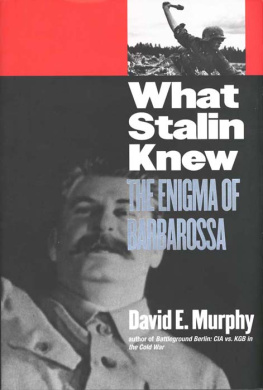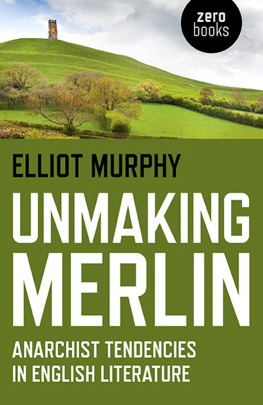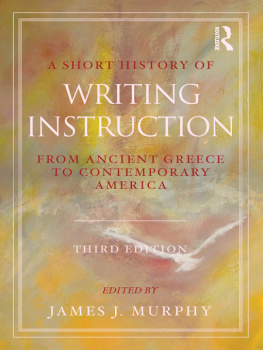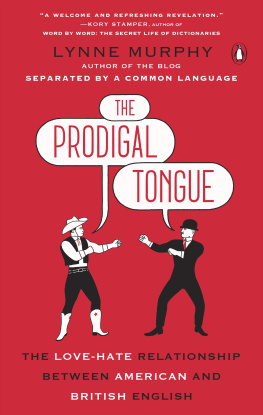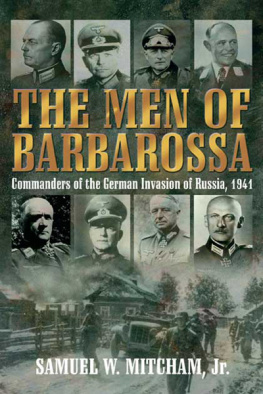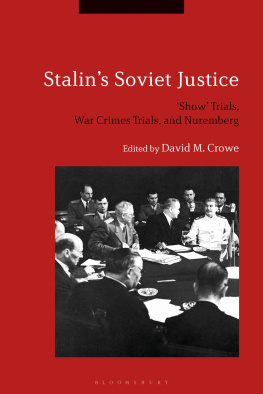W HAT S TALIN K NEW
W HAT S TALIN
K NEW
THE
E NIGMA OF
B ARBAROSSA
David E. Murphy
Yale University Press New Haven & London
Copyright 2005 by David E. Murphy.
All rights reserved.
This book may not be reproduced, in whole or in part, including illustrations, in any form
(beyond that copying permitted by Sections 107 and 108 of the U.S. Copyright Law and
except by reviewers for the public press), without written permission from the publishers.
Designed by James J. Johnson and set in New Aster type by Keystone Typesetting, Inc.
Printed in the United States of America by Vail-Ballou Press.
Library of Congress Cataloging-in-Publication Data
Murphy, David E., 1921
What Stalin knew : the enigma of Barbarrosa / David E. Murphy.
p. cm.
Includes bibliographical references and index.
ISBN 0-300-10780-3 (cloth : alk. paper)
1. World War, 19391945CampaignsEastern Front. 2. Stalin, Joseph, 18791953
Military leadership. 3. Soviet UnionPolitics and government19361953. I. Title.
D 764.M845 2005
940.54217dc22
2004065916
A catalogue record for this book is available from the British Library.
The paper in this book meets the guidelines for permanence and durability of the
Committee on Production Guidelines for Book Longevity of the Council on Library
Resources.
10 9 8 7 6 5 4 3 2 1
For my wife, Star
In the early 1920s, Stalin and a few colleagues were relaxing in Morozovka Park, lying in the grass. One asked: Whats the best thing in the world? Books, replied one. There is no greater pleasure than a woman, your woman, said another. Then Stalin said, The sweetest thing is to devise a plan, then, being on the alert, waiting in ambush for a goo-oo-ood long time, finding out where the person is hiding. Then catch the person and take revenge!
M IKLOS K UN , Stalin: An Unknown Portrait
Contents
Acknowledgments
This book is the result of a suggestion by Jonathan Brent, editorial director of Yale University Press, who first brought to my attention the extensive collection of archival documents on Soviet intelligence being assembled by Aleksandr N. Yakovlev and members of his International Democracy Foundation in Moscow. Brent felt it would be a valuable contribution to an understanding of the events leading up to the German invasion of the USSR on June 22, 1941, if I, as a career intelligence officer, were to examine how the Soviet intelligence services functioned at that time and how Stalin reacted to the information they provided on the German threat. From the outset, Jonathan Brent and his staff at Yale University Press were unstinting in their support of my efforts. Special thanks to my copy editor, Roslyn Schloss, whose herculean work transformed this text.
My research has greatly benefited from the advice and assistance of friends and colleagues in the United States who brought to my attention publications on this subject. Robert Tarleton made available to me material from his own extensive library, as did Harriet Scott, who continues to follow Russian military affairs. My old friend William J. Spahr, Zhukovs biographer, was always ready to respond to my questions. Another friend, Hayden B. Peake, now curator of the CIA Historical Collection, encouraged me in my work, as did CIA historians Kevin C. Ruffner, Donald P. Steury, and Michael Warner. Serge Karpovich, a former colleague and longtime friend, was most helpful in housing me in Moscow, introducing me to friends and relatives there, and untangling particularly difficult Russian sentences encountered in translation.
I owe special thanks to Gennady Inozemtsev for his hospitality and that of his family in Moscow and his help in guiding me through the complexities of Russian bureaucracy and the Russian Internet. Very important was his contact on my behalf with Lidiya Ivanovna Morozova, General Proskurovs daughter, who shared her memories of her father. Sergei A. Kondrashev, my coauthor on Battleground Berlin: CIA versus KGB in the Cold War, also deserves mention for his efforts on my behalf in dealing with the Russian Foreign Intelligence Service (SVR) and for his hospitality in Moscow.
Finally, and most significantly, without the help of my wife, Star, this book would never have been finished. Her encouragement was constant, as were her proofreading and patient transformation of my rough chapters into acceptable computer form.
Sources
My principal resource in the research carried out in writing this book was the two-volume collection of documents 1941 god (The Year 1941) published in Moscow in 1998 by the Mezhdunarodny Fond Demokratiya (International Democracy Foundation) in the series RossiyaXX Vek. According to the principal editor, academician Aleksandr N. Yakovlev, the collection was prepared in response to a 1995 directive from Boris N. Yeltsin, then president of the Russian Federation. The Russian documents were assembled from the Foreign Policy Archive of the Russian Federation (AVP RF), Archive of the President of the Russian Federation (AP RF), Central Archive of the Foreign Intelligence Service (TsA SVR), Russian State Military Archive (RGVA), Russian State Economics Archive (RGAEh), Russian Center for the Preservation and Study of Documents of Recent History (RtsKhIDNI), Center for the Preservation of Current Documentation (TsKhSD), Central Archive of the Defense Ministry of the Russian Federation (TsA MO RF), and Central Archive of the Federal Security Service (TsA FSB). The collection also contains German documents bearing on this period from various archives in the Federal Republic of Germany.
I used two collections of documents in addition to the principal collection by A. N. Yakovlev. One, Organy Gosudarstvennoy Bezopasnosti SSSR v Velikoy Otechestvennoy Voine (Organs of State Security USSR in the Great Fatherland War), was published in two volumes in early 1995 by the Federal Service of Counterintelligence (FSK), later renamed the Federal Security Service (FSB). It contains documents reflecting reporting by both the FSK and the Foreign Intelligence Service (SVR) for the period up to June 1941. It is particularly valuable because it contains detailed biographic summaries on each of the persons named in the documents. The second, Sekrety Gitlera Na Stole U Stalina (Hitlers Secrets on Stalins Desk), was jointly published later in 1995 by the FSB and the SVR. It deals with documents covering just the period of March through June 22, 1941. There is some duplication in entries in both books of documents from the TsA SVR and TsA FSB. Some documents from both publications are also to be found in 1941 god.
The goal of these publications is to demonstrate that in the prewar period the internal security and foreign intelligence services of state security provided the Soviet leadership with ample warning of an impending German attack, yet their reporting was disregarded. The ostensible reasons for this are argued in both books in slightly different ways. In addition, they both present their versions of the events and circumstances that led up to the German invasion of the Soviet Union, contending that France and England, supported by the United States, planned from the early 1930s to direct Germanys growing military might against the USSR in a campaign to eliminate Bolshevism. As a result, the West and the Soviet Union failed to form an anti-Hitler coalition and Stalin was forced to conclude a nonaggression treaty with Germany. I do not agree with this position but it enjoys wide support in official circles in Russia today. It is still used by some to exonerate Stalin for his behavior in the months leading up to the German invasion and to explain the failure of intelligence reporting to sway Stalin from his conviction that if only Hitler were not provoked by Soviet defensive measures, he would not invade until the USSR was better prepared.
Next page
